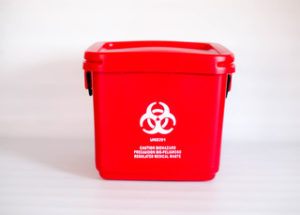Recognizing the Different Kinds Of Garbage Disposal Techniques
In the world of waste administration, the array of disposal methods readily available today is huge and varied, each approach offering a distinct function in dealing with the challenge of garbage disposal. click here. From recycling approaches that aim to offer new life to materials, to the intricate processes of contaminated materials monitoring, the landscape of waste disposal is complicated yet crucial for environmental sustainability. Comprehending the nuances of these different strategies not only clarifies the relevance of accountable waste administration yet additionally triggers us to reconsider our approach towards waste disposal in a swiftly evolving world

Recycling Methods
Recycling techniques are important for lasting waste management methods in both property and commercial setups. medical waste removal. By implementing efficient recycling methods, a substantial quantity of waste can be drawn away from landfills, conserving natural deposits and reducing the environmental influence of production procedures
In residential locations, curbside recycling programs play an essential role in encouraging houses to different recyclable materials from general waste. Products such as paper, plastics, glass, and steels can be arranged and gathered for processing into brand-new products, reducing the need for raw products and energy-intensive production processes.
Industrial facilities additionally depend on recycling approaches to decrease waste generation and advertise a round economic climate. By implementing closed-loop systems, organizations can reuse materials within their production procedures, decreasing expenses and ecological footprint. medical waste removal near me. Furthermore, commercial recycling programs frequently include partnerships with specialized reusing facilities to make certain that products are correctly sorted, refined, and reintegrated into the supply chain
Composting Strategies

Aerated fixed pile composting includes mixing natural waste materials in a big pile and routinely turning it to guarantee appropriate aeration. This strategy is well-suited for smaller-scale procedures and houses.
In-vessel composting entails positioning organic waste in a shut container with controlled problems for temperature level and aeration. Windrow composting includes developing long rows of natural waste and consistently turning them to advertise decay - medical waste disposal.
Land Fill Disposal
Land fill disposal is a typically used approach for managing waste that can not be reused or composted. Methane gas, a byproduct of breaking down natural waste in landfills, is often gathered and utilized as a resource of renewable power. Efforts to minimize dependence on land fills include advertising waste reduction, recycling, and discovering alternate waste disposal address methods to lessen the environmental impact linked with typical landfill disposal techniques.

Waste-to-Energy Incineration
Incineration of waste for energy generation is a method progressively being thought about as an option to traditional land fill disposal techniques. Waste-to-energy incineration involves the burning of waste products at heats, typically in specialized facilities developed to generate electricity or warmth with the procedure - click here. This strategy not just reduces the quantity of waste that would certainly or else be destined for garbage dumps however likewise utilizes the warmth created during incineration to produce energy
One of the vital advantages of waste-to-energy incineration is its ability to generate electrical energy while minimizing the ecological impact contrasted to conventional land fill disposal techniques. By converting waste into power, this method assists in reducing greenhouse gas exhausts and dependence on fossil fuels for power generation. In addition, waste-to-energy facilities are geared up with innovative air contamination control innovations to minimize possible environmental contaminants launched during the burning process.
Contaminated Materials Administration

Considering the essential relevance of responsible waste administration techniques, especially in the world of ecological sustainability, the focus currently moves in the direction of the elaborate domain of Contaminated materials Administration. Dangerous waste presents significant threats to both human health and wellness and the atmosphere, demanding specialized handling and disposal methods. Common instances of contaminated materials include chemicals, batteries, pesticides, and digital waste.
Contaminated materials Management involves the recognition, collection, transport, therapy, and disposal of materials regarded potentially harmful or damaging. This procedure requires adherence to rigorous laws and standards to minimize adverse effect on environments and public health. Different methods are employed in managing contaminated materials, consisting of recycling, protected land fills, encapsulation, and chemical therapy.
Correct Harmful Waste Management is critical for stopping contamination of dirt, water resources, and air pollution. It is important for sectors, labs, healthcare facilities, and other generators of contaminated materials to apply robust monitoring strategies, training programs, and emergency feedback plans to ensure the safe handling and disposal of these materials. Failing to take care of contaminated materials suitably can have far-ranging repercussions, underscoring the importance of thorough and accountable methods in this area.
Verdict
In verdict, garbage disposal strategies play a vital duty in handling and reducing the influence of waste on the setting. From recycling and composting to landfill disposal and waste-to-energy incineration, each approach has its very own benefits and constraints. Correct management of harmful waste is additionally necessary to safeguard public wellness and the atmosphere. It is necessary for sectors and people to recognize the different garbage disposal methods offered and select the most appropriate approach for sustainable waste monitoring.
In the world of waste monitoring, the variety of disposal strategies offered today is substantial and differed, each approach offering a distinctive objective in addressing the obstacle of waste disposal. click here. From reusing methods that intend to provide new life to materials, to the detailed procedures of harmful waste administration, the landscape of waste disposal is complex yet crucial for ecological sustainability. Recognizing the nuances of these different strategies not only loses light on the value of responsible waste administration however additionally triggers us to reassess our strategy towards waste disposal in a quickly progressing world
Efforts to lower dependence on landfills consist of promoting waste decrease, reusing, and exploring alternative waste disposal techniques to minimize the ecological footprint associated with standard landfill disposal methods.
It is important for sectors and people to comprehend the various waste disposal techniques readily available and choose the most proper method for lasting waste management.